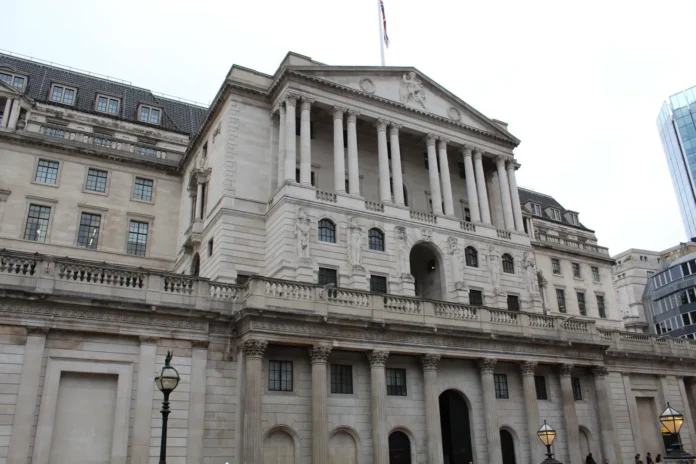The Bank of England has cut interest rates to 4% following a finely balanced vote by its monetary policy committee (MPC).
The decision, which lowers the base rate by 0.25 percentage points from 4.25 per cent, marks the fifth such reduction in a year and brings borrowing costs to their lowest level since February 2023.
The nine-member committee reached the decision after an unprecedented second ballot, the first time a double vote has been required since the MPC was established in 1998.
The initial vote ended in deadlock: four members backed a 0.25-point cut, four voted to hold rates, and one pushed for a more aggressive 0.5-point reduction. A second round of voting saw five members support the quarter-point cut, securing the majority needed for the move.
Inflation will rise to 4% in September from its current rate of 3.6% with the Bank warning of a stronger risk of repeated price increases in the coming years.
The result was announced at noon today.
NOT THE CUT THAT COUNTS

Peter Stimson, Director of Mortgages at the lender MPowered Mortgages, said: “Sometimes it’s not the cut that counts – but the voting. Today is one of those days where ‘god is in the detail’.
“Even though the Bank of England Governor has been hinting for weeks that a base rate cut was all but certain, the voting pattern suggests far from uniform view among his fellow rate setters.
“For four members of the Monetary Policy Committee, last month’s inflationary blowout was sufficiently bad for them to vote to hold rates firm in an effort to rein in the rapidly rising cost of living. At 3.6%, CPI isn’t far off double the Bank’s 2% target as so far, is still heading in the wrong direction!”
DOVES WON THE DAY
But he added: “Whilst the Committee’s doves have won the day with a view that the increasingly gloomy economic outlook, with slowing growth and employment warrant a cut, the narrowness of their victory will set many thinking that the next rate cut may be some time off.
“The swaps market – which largely determines fixed mortgage rates – had priced in today’s cut and indeed future rate cuts, and may well see, based on the voting pattern and minutes, a continued cautious, slow and steady approach to rate reductions in the months ahead.
“On this basis, borrowers are unlikely to see any material changes to their mortgage rates in the immediate term, simply as it is already priced into the swap curves.
“The only thing that is really going to drive any material change is a significant fall in CPI, allowing the hawks at the bank to agree that the beast of inflation has finally been tamed. For this, we eagerly await the inflation numbers in the weeks ahead!”
CLEAR SIGNAL

Simon Gammon, Managing Partner, Knight Frank Finance, added: “Today’s rate cut sends a clear signal that the Bank of England is now more focused on slowing growth and rising unemployment rather than the threat posed by inflation.
“The split vote – with members supporting everything from a hold to a 50 basis point cut – underlines how finely balanced the decision was.
“But the direction of travel is clear. Borrowers now believe mortgage rates are more likely to fall than rise, and that’s lifting sentiment across the market. If current trends persist, we could see sub-3.5% mortgage rates by Christmas.”
BORROWER UNCERTAINTY REMAINS

David Hollingworth, associate director at L&C Mortgages, said: “The cuts to base rate continued as expected but the decision was a closer call than may have been expected.
“Four members wanted to hold base rate with a majority of five ultimately voting for the quarter point cut, taking base rate back to a level not seen since February 2023 when rates were on the up.
“It would have been a shock if the rate hadn’t fallen today but the split in voting underlines that there remains a good degree of uncertainty for borrowers.
“The good news is that market expectation that these cuts would feed through has already allowed lenders to trim rates. That’s providing a good range of fixed rates below 4% as lenders improve where they can.”
INDUSTRY REACTION

Paul Noble, CEO of Chetwood Bank, said: “Today’s rate cut will be welcomed, but it’s slow progress for an economy that’s in desperate need of a kickstart.
“Domestically and globally, the economy has taken a beating over the last year, but a trade deal secured with the US is one factor that has started to ignite some flickers of hope and likely prompted the MPC to continue to ease off on the brakes.
“However, inflation remains above target, and many will argue that the MPC should have not only acted sooner but acted more decisively too. After all, leadership isn’t just about reacting when conditions are safe – it’s about shaping the path forward.”
And he added: “Caution has been the watchword on Threadneedle Street for a long time now, with rates slow to go up when inflation began to skyrocket and then slow to come down with inflation more settled.
“What was really needed today was bolder action to catalyse the economy and really create growth, rather than more tentative tiptoeing.
“Nevertheless, today’s decision should be seen as a green light by investors. Rates are now far below their peak, and the lending markets should respond in turn. Pent-up demand can now be released, and we should expect activity levels to rise in the aftermath of today’s news.”
REPRICING ESSENTIAL

Paresh Raja, CEO of Market Financial Solutions, said: “Inflation might remain above the 2% target, but a softening labour market and sluggish economic growth mean the Bank of England is justified in taking this action.
“More of the ‘wait-and-see’ approach looked like doing more harm than good, and this is likely to provide the UK property market with a real boost.
“Borrowers might not see an immediate changes. After all, the markets had been expecting this cut for some time, and many lenders have already reduced their rates in preparation. But every cut will be welcomed and will undoubtedly help to unleash pent-up demand, driving increased activity in the coming weeks, particularly during the typically busy period as the summer holidays draw to a close.”
And he added: “Lenders need to remain proactive in the final five months of the year. The expectation is for more base rate reductions, so product repricing and flexible lending solutions are essential for supporting borrowers and their brokers. Today has brought some good news, and it’s vital the property market can capitalise on it.”
TAILORED SUPPORT

Alpa Bhakta, CEO of Butterfield Mortgages, said: “Today’s rate cut will be welcomed by the Prime Central London (PCL) market. 2025 has been a challenging year so far and lower rates will help to boost borrower confidence.
“That said, many investors remain cautious and are seeking greater stability before committing to their investment plans.
“Lenders need to continue providing the tailored support and transparency required to navigate the market and maintain momentum.”
MODEST BUT WELCOME

Iain McKenzie, CEO of The Guild of Property Professionals, said: “This modest but welcome 0.4% rise is another brick in the wall of a steadily recovering market. The engine room of this recovery is undoubtedly improved affordability.
“With mortgage payments for first-time buyers returning towards their long-term average and lenders offering more competitive rates, buyer confidence is being rebuilt on solid foundations.
“This is translating directly into action, with agreed sales and mortgage approvals both showing healthy year-on-year growth.
“However, this is a story of steady normalisation, not a return to a runaway market. Buyers remain highly price-sensitive, and an increase in available properties is keeping a lid on any dramatic price hikes.
“For the remainder of the year, we expect this pattern of moderate, sustainable growth to continue. All eyes are now on the Bank of England’s decision this afternoon, which will be a critical signpost for the market’s direction in the months ahead.”
TIMELY MOVE

Kevin Shaw, national sales managing director at national estate agent LRG, said: “The Bank of England’s decision to cut the base rate by 0.25% is a welcome and timely move for both the property sector and the economy more generally.
“With the rate now back to where it was in March 2023 and a further cut likely before the end of the year (probably in November), this provides renewed momentum for buyers, sellers and developers alike.
“After a sluggish spring for GDP, with declines in both April and May – not helped by the Trump lumps and bumps – the Bank has rightly judged that now is the moment to ease the brakes.
“A property-led approach to growth has been a priority of this government for the last year, and we are now seeing that strategy bear fruit. With careful monetary easing, the sector now growing in a measured, and therefore, a sustainable way.”
“There are headwinds on the horizon.”
But he added: “There are, however, headwinds on the horizon. October’s Budget is likely to bring tax changes, and there has been little, so far, to suggest that the government will respond to the sector’s repeated pleas for fiscal measures to support the property industry, such as a reduction in stamp duty.
“The Chancellor will need to be very careful not to implement tax changes which offset the benefits of falling interest rates and risk stalling recovery.
“The property market remains very price-sensitive. While for many, this interest rate cut will help mitigate the rising cost of living alongside any future tax increases, those gains must not be undone.
“The market does not appear to be in any danger of overheating; it is responding to improving conditions in a cool and measured manner. We expect that to continue, and early signs from our sales figures suggest that property will remain a vital driver of growth for the economy.”
TIME TO BE HONEST

Colin Bell, founder and COO of Perenna, said: “This cut means one thing for certain – the housing market will continue to heat up, fuelled by the narrative that rate cuts would solve all the affordability woes for those looking to get on the ladder.
“While it is indeed music to the ears of existing owners wanting to sell and upgrade their home, or older generations cashing out and downsizing for their retirements, for first time buyers, it’s more like a screeching violin solo they’re being told they should enjoy.
“It is time to take off our rose-tinted glasses and be honest with our young people. The big blocker on housing affordability is the overall price, not the monthly payments.
“Many young people are already paying a small fortune in rent. We should stop acting like rate drops are a silver bullet solution to their housing woes. In fact, this rate cut will have done very little for first time buyers who simply can’t get over the house price hurdle, let alone secure a low-rate mortgage.”
BALANCE HAS SHIFTED

Jo Carrasco, Business Partnerships Director at Stonebridge, said: “Today’s rate cut sends a clear signal that the Monetary Policy Committee believes the greater risk now lies in a faltering economy rather than entrenched inflation.
“While inflation remains nearly double the Bank of England’s target, the balance has shifted. Wage growth is easing, the labour market is softening, and GDP data shows the economy retracted in May.
“Meanwhile, the Bank appears increasingly confident that inflation will roll back next year, creating room to begin loosening policy.
“Unless the economic outlook improves significantly, we expect at least one further cut before the end of the year, providing relief for borrowers on variable-rate mortgages.
“It could also accelerate the downward trend in fixed mortgage pricing. Sub-4% deals are already widespread, supported by falling swap rates and intense competition among lenders.”
WELCOME AND NECESSARY

Steve Cox, chief commercial officer at Fleet Mortgages, said: “Today’s decision by the Bank of England to cut Bank Base Rate to 4% is both welcome and necessary, given the current economic backdrop.
“With GDP falling in both May and June, there has been a growing expectation that the MPC would have to act, even with inflation rising in June and being above the 2% target at 3.6%.
“In a sense it shows the Bank has sensed there is a trade-off here and has come down on the side of trying to improve economic growth.
“Many analysts had warned of the risks of holding rates too high for too long, and this cut helps to ensure monetary policy does not compound those pressures while also delivering a clear boost for borrowers and the housing market.”
GOOD TIME TO BUY

Ben Thompson, deputy CEO at Mortgage Advice Bureau, said: “The Bank of England’s latest rate reduction will provide even more incentive for aspiring homeowners to step onto the property ladder.
“It was already a good time to buy, but this latest move makes it even more attractive. Lenders are continually adjusting their criteria, and it’s increasingly possible to borrow more than you could last year, opening up the mortgage market significantly.
“However, we recognise a major challenge: many potential borrowers simply aren’t aware of the full spectrum of mortgage options available to them. Our research reveals that 27% of renters believe they’ll never be able to afford their first home – a figure we’re determined to change.
“While we’ll have to wait and see if another rate cut is on the horizon before the year ends, the message is clear: if homeownership felt out of reach to you before, today’s climate offers a significantly stronger chance.
“With the expert guidance of a mortgage adviser, I strongly encourage aspiring buyers to take full advantage of the market and unlock the considerable financial benefits and long-term security that homeownership offers.”
GOOD NEWS FOR BROKERS

John Phillips, CEO of Just Mortgages and Spicerhaart, said: “It’s great to see the central bank putting the economy ahead of inflation when making today’s decision.
“While inflation has risen and is nearly double target, it importantly remains well within the bank’s broader forecast, which has long predicted a peak in Q3 before beginning to come back down.
“With a hold last month, the bank doesn’t have to stray too far from its gradual approach and critically gives the UK economy the adrenaline shot it so desperately needs.
“There’s no doubt that many lenders will have already factored this into their pricing, but it remains a powerful piece of good news for brokers to be sharing with potential clients.
“Lenders have been staying competitive, all while continuing to innovate and seize opportunities to increase access and improve affordability.
“While we’ve certainly seen some bold rate predictions for the rest of the year and beyond – with some predictions of three more cuts – I’m hopeful this isn’t the last one we’ll see this year as inflation hopefully turns a corner and the central bank prioritises the health of the economy.”
AFFORDABILITY BOOST

Mark Harris, chief executive of mortgage broker SPF Private Clients, said: “The Bank of England has reduced rates by a quarter point to 4 %, which comes as no real surprise even though CPI inflation ticked up to 3.6% in the year to June.
“The fifth quarter-point reduction in a year points to a slow and steady pattern in reductions as the Bank wants to be certain that inflation is under control before it takes more drastic action.
“However, while the Bank is tasked with keeping inflation at 2%, there is an argument that lower interest rates are needed to stimulate the flagging economy.
“A bolder, half-point reduction, would have sent out a strong message, helping boost the housing market and wider economy, particularly as the stamp duty concession has now ended.
“Swap rates continue on a downwards path with lenders reducing mortgage rates in recent weeks and a plethora of sub-4 per cent deals now available.
“This latest rate reduction was largely expected and has been factored into pricing already. However, it’s not just pricing that is improving as lenders are also broadening policy, including increasing loan-to-income caps and lowering some income requirements, which is boosting affordability.”
RATE CUT CATALYST

Matt Smith, Rightmove’s mortgage expert, said: “As expected we now have the third Bank Rate cut of the year, with the Bank continuing along its forecast trajectory.
“Mortgage lenders have had a bit of room to reduce rates over the last week, owing to the ongoing developments around global tariffs.
“However, we expect that lenders will use the headline of today’s cut as the catalyst to reduce their rates a little further, though lender competition remains fierce and we don’t expect major rate drops.
“Lenders have been competing for business in a market which has the largest supply of homes for sale in a decade. A combination of rate cuts and changes to buyer affordability criteria are helping many home-movers to responsibly borrow more towards the home that they want.
“The market expects there will be one more Bank Rate cut before the end of the year, with an outside chance of two.
“Any further cuts would likely see this cycle repeat again – with lenders using it as an opportunity to reduce rates a little more. It bodes well for the second half of this year, with further mortgage rate reductions and stable prices likely to encourage more activity.”
WIDELY FLAGGED

Daron Kularatnam, group treasurer at Glenhawk, said: “This [25bps] rate cut was widely flagged, and is overdue, given growing concerns around the economic outlook and a cooling labour market.
“The BoE’s more cautious stance of late has been driven by stubbornly high core inflation, despite indications of downward pressure across several relevant measures.
“For UK real estate investors and developers, it will require signs that the BoE is committed to a series of cuts before sentiment improves markedly.”
SURGE IN DEMAND

Joe Pepper, UK Chief Executive Office at PEXA, said: “The reality is that today’s base rate cut will have very little impact on the vast majority of existing mortgages.
“Those on interest only or tracker mortgages will see their rates drop, but those on fixed rates will not see any change because the cut was predicted and has already been priced into the market by lenders.
“For first time buyers and remortgagers still looking for the best deal, though, it is good news – as swap rates have fallen in anticipation of today’s news, fixed rates have followed suit so someone looking to secure a mortgage now could benefit from a significantly lower rate than they would have encountered this time last year.
“With additional measures being considered to boost affordability such as the LTI cap changes and stamp duty reform, as well as promises of more housing stock and increasing transaction data signalling already improved buyer confidence, conveyancers are bracing themselves for a surge in demand.
“Plain and simple, any surge like this could be the straw that breaks the camel’s back – the infrastructure behind the market is already teetering on the edge of collapse, and if we don’t improve the way in which we transact property urgently, we could end up looking back in a few months and wish we’d done more to save the camel.”
BUILDING POSITIVITY

Richard Donnell, Executive Director at Zoopla, said: “While today’s cut in the base rate is welcome news for businesses and consumers, it’s unlikely to make a major difference to the cost of mortgages for home buyers or deliver a boost to house prices.
“The price of fixed rate mortgages already factors in the future path of base rates meaning average mortgage rates are likely to remain broadly where they are today.
“However, changes to the way banks assess mortgage affordability over recent months have already delivered a 20% boost to what people can borrow with no change in average mortgage rates.
“This has been supporting unseasonably strong levels of housing market activity, with the most homes for sale in over seven years. This cut to the base rate will support more positive housing market sentiment amongst home buyers.”
CRUCIAL OPPORTUNITY

Mark Michaelides, chief commercial officer, Molo, said: “The slim 5-4 majority in favour of the Bank of England’s 0.25% rate cut reflects the stark competing pressures of stubborn inflation and a slow-growth economy.
“However, a fifth rate cut in the past 12 months also illustrates continued momentum on the downward path of interest rates, with many lenders already having reduced rates in anticipation.
“For brokers, this is a crucial opportunity to help clients reassess their options, whether they’re nearing the end of a fixed deal or looking to improve affordability.”
STABALISING INFLUENCE

Gareth Lewis, deputy CEO at specialist lender MT Finance, said: “The MPC’s decision to reduce the base rate is a direct response to persistent economic headwinds, including the impact of unemployment, tariffs, and lingering inflationary pressures.
“This move is intended as a stabilising influence, offering a much-needed buffer against a volatile environment.
“While it does not signal an immediate return to robust economic positivity, it aims to prevent further downturns and provide a foundation for cautious growth.
“For property investors, this provides a clearer, albeit still uncertain, outlook on borrowing costs, which could encourage some new projects and acquisitions in a more stable, though still volatile, market.”
POSITIVE SHIFT

Stephanie Daley, Director of Partnerships at mortgage advisor Alexander Hall, said: “We’ve already seen significant strength return to the mortgage sector since interest rates began to stabilise and trend downwards.
“Today’s decision to further reduce the base rate will only serve to fuel this momentum, easing the cost of borrowing for the nation’s homebuyers even further.
“This welcome boost comes in addition to the recent decision to make the Mortgage Guarantee Scheme permanent, alongside the loosening of income lending restrictions, both of which have already had a positive impact on mortgage affordability.
“As we move into the second half of the year, this positive shift in the mortgage landscape is expected to support sustained demand and contribute to the long-term resilience of the market.”
FRESH MOMENTUM

Tony Hall, head of business development at Saffron for Intermediaries, said: “Today’s decision to cut the base rate was to be expected after policymakers signalled the move despite a recent spike in inflation.
“Lenders have already adjusted, and we’re now seeing a rise in competitive mortgage products, including several below 4%, though global market pressures mean some variation remains.
“The timing is significant, following the Government’s Plan for Change, the most substantial regulatory shake-up in a decade.
“Announced in July by Chancellor Rachel Reeves, the reforms aim to boost homeownership by cutting financial red tape, potentially unlocking up to 36,000 extra mortgages for first-time buyers and increasing borrowing limits to over 4.5 times salary.
“Together with the rate cut, these changes could bring more buyers into the market and inject fresh momentum as we head into autumn.”
CAUTIOUS RELIEF

Thomas Lambert, financial planner at Quilter, said: “Today’s rate cut is likely to bring a sense of cautious relief to borrowers, particularly those approaching the end of fixed-rate mortgage deals taken out during the peak of the rate-hiking cycle.
“With the Bank Rate now at 4.00%, lenders may start to reflect the lower cost of funding in new deals, but changes are unlikely to be immediate or uniform across the market.
“For those on variable or tracker mortgages, some changes may come through more quickly.
“That said, average mortgage rates remain significantly higher than the ultra-low levels borrowers became accustomed to during the 2010s.
“Even with this latest reduction, the cost of borrowing is still meaningfully above pre-2022 norms, and the affordability challenge remains acute for first-time buyers and those looking to move up the housing ladder.
“Markets currently expect the Bank to cut rates once more this year, potentially taking the base rate to 3.75% by year-end.
“But progress is likely to be slow and data-dependent, meaning those making major borrowing decisions should continue to plan on the basis of a more elevated interest rate environment.”
LENDERS MUST REMAIN AGILE

Richard Pike, chief marketing and sales officer at Phoebus, said: “Today’s decision by the Bank of England to cut the base rate is no surprise, given the growing economic pressures facing the UK.
“Although inflation remains stubbornly high, the MPC is clearly prioritising economic support in the face of slowing growth, rising unemployment and falling consumer confidence.
“Rachel Reeves will, no doubt, have been praying for this cut as it will go some way to relieving the increased pressure she faces about potential tax rises looming at her autumn budget.
“And it will also provide some relief to mortgage holders, particularly those on variable rates or coming to the end of fixed-term deals as households face higher living costs and tax pressures.
“For the housing market, this decision adds a layer of cautious optimism. While interest rate cuts don’t fix the structural issues around housing supply and affordability, lower borrowing costs do have the potential to unlock activity, especially among first-time buyers.
“That said, persistent inflation, uncertainty over the government’s fiscal plans, and the global backdrop mean that lenders must remain agile.”
CHALLENGES REMAIN

Andrew Gething, managing director of MorganAsh, said: “The Chancellor has been clear that she is looking to drive economic growth – something that is arguably hard to do when interest rates sit so high.
“With the economy stagnating and facing stiff headwinds, a cut to the base rate is much needed to help alleviate this and encourage some positive activity.
“It’s a move that borrowers will welcome as will those households which feel burdened by significant financial pressures.
“Of course, much of this is based on the expectation that inflationary pressures will subside as the central bank predicts.
“However, if there’s one thing that inflation continues to demonstrate, it is the difficulty to confidently predict its future path – especially with trade policy proving so uncertain and clear challenges on our own shores.
“For financial services firms, there will still be a need to stay close to their clients – particularly those in difficulty or with characteristics of vulnerability.
“The challenge remains that many firms still cannot identify who these customers are and therefore cannot provide adequate support or facilitate positive outcomes.
“Firms absolutely need to equip themselves with the tools and technology to properly respond to the growing need within their own customer base, regardless of the path of inflation or interest rates.”
GROWTH DRIVER

Jonathan Samuels, CEO of Octane Capital, said: “The Bank of England’s decision to cut the base rate today is a welcomed move, offering a much-needed boost to the property market and building on the momentum seen over the last 12 months.
“While inflation remains a concern, we’ve already seen many lenders acting in anticipation of today’s cut and the resulting reduction in borrowing costs will provide immediate relief, not just to the nation’s homebuyers, but also to those within the industry looking to utilise specialist lending products.
“A rate cut will further encourage developers to push forward with projects and bring much needed housing stock to the market and specialist lending plays a crucial role here, by offering flexible and accessible financing,
“As we move into the second half of the year, the combination of lower borrowing costs and the support from specialist lenders will be key in driving continued growth in the property sector.”
CONFIDENCE BUILDER

Thomas Cantor, co-head of short-Ttrm Finance at West One Loans, said: “While the Bank of England’s decision to cut the base rate today is a positive move for the property market, it’s important to note that this move has already been largely priced in by lenders.
“The expectation of a rate cut has been building for some time, however, it will continue to support market confidence and allow developers to move forward with critical housing projects.
“Specialist finance will continue to play a key role in ensuring projects are funded and completed, contributing to the ongoing stability and growth of the property sector.”
RATES WILL CONTINUE TO DROP

Nick Jones, the mortgage sales and marketing director at Access FS, said: “Despite inflation data for June coming in at 3.6%, markets were pricing in a 97% chance of a rate cut today.
“So, this wasn’t exactly a surprise. What’s been cloudier for a while is where the Bank of England goes from here.
“Personally, I think it is now much more likely that best-buy rates could come close to 3% next year. The lowest rates available at the moment – for people with big 40% deposits or lots of equity in their homes – are just over 3.7%.
“Given the base rate was 5.25% in August 2023, that’s already looking pretty positive.
“But if the MPC continues to lower the base rate – especially if inflation weakens and the labour market softens further – mortgage rates could continue to drop into 2026.”
THE BUDGET AWAITS

Charles Resnick, Chief Finance Officer at Afin Bank, said: “The markets have been predicting a base rate cut since the last announcement back in June, so today’s 25bps drop to 4% is no surprise.
“But the MPC’s minutes and voting breakdown will be more illuminating as they will show how much of a split there is in the committee and give a hint at the future direction of base rate travel.
“At 3.6%, inflation is still way above the Bank of England’s 2% target, while signs of economic growth are thin on the ground.
“The country, and the markets, are holding their breath to see what Chancellor Rachel Reeves announces in her Autumn Budget later in the year and whether this would likely lead to further base rate cuts towards the end of the year and into 2026.”
TIME TO STREAMLINE

Nick Hale, CEO of Movera, said: “The Bank of England’s decision to cut interest rates for the third time this year by 25 basis points is a welcome boost for the mortgage market, with some lenders already reducing their rates ahead of time.
“Crucially, this continues to offer relief for borrowers and should lead to an increase in buyer momentum and demand for remortgages.
“With further interest rate cuts expected to follow – enabling transactions to increase further – it is crucial that the sector works quickly to streamline the homebuying and remortgaging process to ensure these transactions are dealt with quickly and efficiently.
“Our aim is to support the industry through this process, providing digital products and solutions that can make this a reality.”
HEALTHY MARKET

Kevin Roberts, managing director of L&G’s Mortgage Services, said: “The Bank of England’s decision to cut the base rate is a welcome boost for borrowers.
“The mortgage market is in good health – lenders are competing strongly and introducing innovative products following affordability rule changes to support first-time buyers, who now account for 60% of all mortgage broker searches with L&G.”
NEW OPPORTUNITIES

Ryan McGrath, director of second charge Mortgages at Pepper Money, said: “Interest rates have fallen to their lowest level in over two years, providing immediate relief for customers on tracker products who will see reduced monthly payments.
“This improved rate environment makes second charge mortgages increasingly attractive, particularly for homeowners locked into favourable primary mortgage rates who need additional funding without disrupting their existing arrangements.
“While today’s modest rate cut signals measured caution rather than a fundamental shift, it creates opportunities for those whose circumstances fall outside traditional lending criteria.
“With property transactions remaining subdued and economic pressures mounting, including falling payroll numbers and rising unemployment, secured loans offer a vital lifeline, allowing homeowners to unlock equity to for necessary home improvements or to consolidate high-interest debt into a single, manageable payment at typically lower rates.”
BALANCING ACT

Leon Diamond, CEO at LiveMore, said: “The Bank of England’s decision to reduce the base rate to 4% reflects the delicate balancing act between curbing inflation and supporting a slowing economy.
“While inflation remains above target, signs of a weakening labour market and falling consumer confidence have clearly tipped the scales toward easing monetary policy.
“This is a welcome move for many older borrowers. Lower rates can reduce monthly repayments or improve affordability assessments.
“For customers reliant on fixed incomes or navigating retirement planning, even modest reductions in borrowing costs can make a real difference.
“That said, it’s important to remember that rate cuts alone won’t unlock financial resilience for the over-50s.
“We need a more flexible lending environment that recognises the diversity and complexity of later life finances. This includes smarter regulation, innovation in product design, and a shift in the industry mindset about what older borrowers can and should be able to do.”
FAVOURABLE DEVELOPMENT

Adrian Hall, the director of surveying at digital platform HouzeCheck, said: “Despite persistent inflation, it was almost certain the interest rate would be cut – the only uncertainty was the magnitude of the reduction.
“Given the number of job vacancies continues to decrease and is now below pre-pandemic levels, and with unemployment rising to 4.7%, the highest level since June 2021, it was widely anticipated the bank rate would decrease to at least four per cent. There is no longer concern regarding wage growth.
“This development is highly favourable. Falling mortgage rates benefit not only first-time buyers but also millions of households planning to remortgage in the coming years.
“The current question facing the Bank of England is the direction of future policy. Is this the final rate cut of 2025?
“Alternatively, could the Morgan Stanley team be correct in predicting that interest rates will decline to as low as 2.75% in the first half of the upcoming new year, ultimately reaching 2%”
BREATHING ROOM

Nick Smith, group managing director at Reward Funding, said: “We welcome today’s decision by the Bank of England to reduce the base rate to 4%, supporting the ‘gradual and careful’ approach Governor Andrew Bailey highlighted.
“For SMEs across the UK, this move provides some much-needed breathing room to help tackle the weakening labour market and ongoing difficult economic times. The recent 0.1% upgrade in 2025 growth forecasts by the International Monetary Fund also comes as a small light in the dark.
“SMEs are considered the lifeblood of the UK economy, and this rate cut shows that the Bank of England and wider policy committees are supporting them in a time of need.
“It is a step in the right direction towards enabling growth, investment and job creation.
“Although inflation remains a concern, this decision shows an understanding of the struggles SMEs face on a daily basis. We would encourage this trajectory to continue with ongoing rate reductions in 2025 and into 2026.”
BACK ON THE FRONT FOOT

Kai Hunter, Non Executive Director at Love Finance, said: “The Bank of England cutting rates to 4.0% is a real boost for UK SMEs.
“After a tough couple of years with rising costs and cautious spending, this gives businesses some much-needed breathing space, a chance to plan, invest, and move forward with a bit more confidence.
“That said, cashflow’s still a major pressure, especially in sectors like construction, hospitality, and transport.
“When margins are tight, waiting weeks or months for funding just isn’t an option. Speed and access really matter now.
“If financial services can keep pace with this shift, it could make a big difference for businesses looking to get back on the front foot. Looking back, it’s good to see the momentum finally starting to turn.”
HEADING FOR RECESSION

Luther Yeates, Head of Mortgages at Orton Financial, said: “It is great to see the Bank making moves to stimulate the economy and support growth.
“But there are still significant downward pressures due to increases in taxation on individuals and businesses.
“We are unlikely to see any meaningful benefit from the reduction in base rate, and it will instead slow the decline and move towards recession.”
EMERGENCY FUND IS CRUCIAL

Sarah Pennells, consumer finance specialist at Royal London, said: “The Bank of England has cut the base rate to its lowest level since March 2023, which will be good news for borrowers who have a tracker or variable rate mortgage.
“A lower base rate can reduce borrowing costs for those on a variable or tracker rate mortgage, but it also means savers may see lower returns on their savings.
“Our latest Financial Resilience report shows that the average amount people have in savings is £15,864, rising to £24,122 for those over 60, and a 0.25% fall in savings rates could mean £5 less a month in interest for that population.
“This may not seem significant but almost one in five adults (18%), or 15% of over-60s, are overdrawn at the end of the month or have no money left, so it could have an impact on budgets.
“Any reduction in mortgage payments will be welcome as more than half of mortgage borrowers have seen their monthly housing costs rise over the 12 months to March, by an average of £327.
“Single-adult households and renters are particularly vulnerable, with 71% of renters seeing their housing costs rise by an average of £233 a month in the same period.
“Falling interest rates can discourage people from saving, but building up an emergency fund is crucial to improve financial resilience.
“Our research shows that one in five people have less than £100 in savings, which means they are exposed to future rises in costs or unexpected bills.
“That’s why it is important to seek financial advice or guidance, and ensure you’re making informed decisions that protect your financial wellbeing, whatever the interest rate environment.”
HELPFUL BOOST

Adam Ruddle, chief investment officer at LV=, said: “The Bank of England’s decision to reduce rates to 4% seemed increasingly likely as falling employment rates signalled economic weakness.
“Despite headline inflation persisting at 3.6% and services inflation projected to remain above 3% well into next year, this announcement aligns with the Bank’s strategy to gradually decrease the rate.
“This reduction marks the third cut this year and will once again be welcome news to homeowners and prospective buyers, as lower interest rates may lead to lower mortgage rates.
“According to LV’s Wealth and Wellbeing research, more than a third (36%) of mortgage holders are worried about the future.
“This reduction may alleviate some of these concerns, especially for people looking to remortgage at a lower rate.
“This further decrease in interest rates will be a helpful boost for the broader economy, helping to stimulate economic activity as the cost of financing falls and consumers and businesses have more capital to invest.
“We expect the Bank will now pause before continuing to lower interest rates later this year.”
MEASURED APPROACH

Dean Butler, managing director for retail direct at Standard Life, part of Phoenix Group, said: “Today’s 0.25% rate cut continues the Bank of England’s measured approach to easing monetary policy, following a cut in May and a hold in June.
“While not unexpected, it reinforces the Bank’s cautious response to a challenging economic backdrop. Interest rates are now at their lowest level in two and a half years, reflecting growing concerns about economic momentum and a softening labour market.
“While inflation remains way above the 2% target, the Bank is clearly attempting to support growth without reigniting price pressures – a delicate balancing act.
““For borrowers, particularly those on variable rate mortgages or nearing the end of fixed-term deals, this move offers some relief.
“However, with household budgets still under strain from high living costs, the impact may be gradual rather than immediate. The path ahead remains uncertain, and further rate cuts in 2025 are not guaranteed.”





